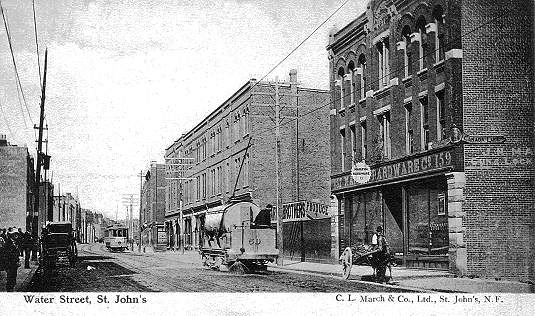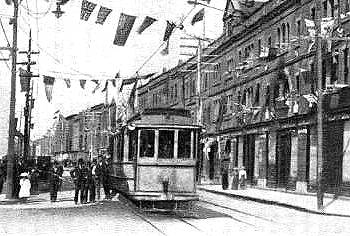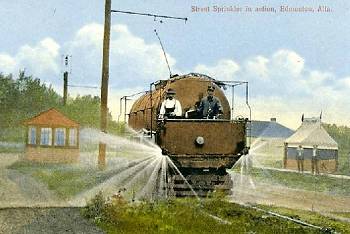

This view includes something which is quite unusual to find on a picture postcard, that is a water (or sprinkler) car. The location is in Water Street in St. John's, Newfoundland. The card was published around 1905 by C. L. March & Co. Ltd. of St. John's. A more conventional tram (streetcar) can be seen a little further along Water Street in the smaller view below, which is from a postcard published in 1904 by the Newfoundland Postcard Co. The other small view is from a card from an unknown publisher and shows a similar water car in Edmonton, Alberta
 St. John's, the oldest English-founded city in North America, is on the Avalon peninsular on the east coast of Newfoundland Island. It is the provincial capital of Newfoundland and Labrador, which was independent until 1949 but is now the tenth province of Canada. Water Street was developed in the early 16th century, and is the oldest street in North America. St. John's has technological fame as it was the place where in 1901 Marconi received his first transatlantic wireless signal, and from where in 1919 Alcock and Brown commenced the first non-stop transatlantic aircraft flight.
St. John's, the oldest English-founded city in North America, is on the Avalon peninsular on the east coast of Newfoundland Island. It is the provincial capital of Newfoundland and Labrador, which was independent until 1949 but is now the tenth province of Canada. Water Street was developed in the early 16th century, and is the oldest street in North America. St. John's has technological fame as it was the place where in 1901 Marconi received his first transatlantic wireless signal, and from where in 1919 Alcock and Brown commenced the first non-stop transatlantic aircraft flight.
The St. John's Street Railway Company was incorporated in Newfoundland on 10th November 1897, tracks were laid in 1899 and the first tram ran on 1st May 1900. The line was built by entrepreneur Robert Reid, who also operated Newfoundland Railways which had its main station in Water Street (now a railway museum). The name was changed to the Reid Newfoundland Company in 1901, with the company also supplying electric power, and in turn was reorganized as the St. John's Light & Power Company in 1920, a subsidiary of Reid Newfoundland. In 1924 this subsidiary was sold to International Power and its name changed to the Newfoundland Light & Power Company Limited.
When complete, as well as on Water Street the tramway ran on Duckworth Street, Queen's Road and Military Road, and prior to 1902 on New Gower Street and Hamilton Avenue. The original trams were built by N. & A. C. Larivière of Montreal. The last tram ran in St. John's on 15th September 1948, with motor buses taking over the services.
 In the early days of tramways there were large deposits of mud and horse dung in the streets. In the summer there was excessive dust. In addition, build up of such debris in the grooves and on the rail head could insulate the wheels and cause electric trams to get stuck. To compensate the tracks were cleaned by water cars. These were, to a large extent, rectangular or cylindrical metal tanks of 1500 to 5000 gallon capacity, fitted on a motorized chassis. Later some had a roof to protect the crew, but early ones were completely open. Some American versions had arms which swung out to cover the whole street, but mostly they just sprayed the tram track. Water was supplied to jets by gravity, compressed air or centrifugal pump. Some cars were also fitted with brooms to sweep the track and occasionally with carborundum blocks that could be pressed onto the rail head to act as grinders and remove corrugations. In the US water cars similar to the St. John's one were built by the J. G. Brill Co. of Philadelphia, the McGuire Manufacturing Co. of Chicago and others. In the UK such cars were built by the Brush Electrical Engineering Co. Ltd. of Loughborough, Dick Kerr and its associates at Preston, Mountain & Gibson Ltd. of Bury and others.
In the early days of tramways there were large deposits of mud and horse dung in the streets. In the summer there was excessive dust. In addition, build up of such debris in the grooves and on the rail head could insulate the wheels and cause electric trams to get stuck. To compensate the tracks were cleaned by water cars. These were, to a large extent, rectangular or cylindrical metal tanks of 1500 to 5000 gallon capacity, fitted on a motorized chassis. Later some had a roof to protect the crew, but early ones were completely open. Some American versions had arms which swung out to cover the whole street, but mostly they just sprayed the tram track. Water was supplied to jets by gravity, compressed air or centrifugal pump. Some cars were also fitted with brooms to sweep the track and occasionally with carborundum blocks that could be pressed onto the rail head to act as grinders and remove corrugations. In the US water cars similar to the St. John's one were built by the J. G. Brill Co. of Philadelphia, the McGuire Manufacturing Co. of Chicago and others. In the UK such cars were built by the Brush Electrical Engineering Co. Ltd. of Loughborough, Dick Kerr and its associates at Preston, Mountain & Gibson Ltd. of Bury and others.
Also see or range of Works Car photos.
![]() Go to Postcard Of The Month Index
Go to Postcard Of The Month Index